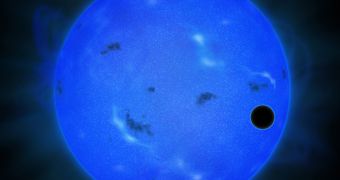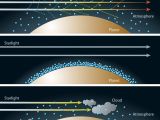One of the big questions pestering every astronomer out there is whether there is life in the universe.
Granted, most astronomers are convinced that there is, the problem is finding it. This quest has been a big focus of astronomy, particularly lately when we've started discovering exoplanets in bulk.
But our methods are still only good enough to discover larger planets which don't resemble the Earth. The best candidates for life search are the so-called super Earths, planets that are larger than the Earth, hence the "super" moniker, but are rocky planets like our own.
At least, that's the presumption; there's also the possibility that some of these super Earths may be more similar to Uranus or Neptune, both with thick gaseous atmospheres, rather than Earth.
So new research into one of the closest and most interesting super Earths, Gliese GJ 1214b, we know off is proving very interesting. By looking at the planet through a blue color filter, astronomers were able to determine that the planet has a water-rich atmosphere.
Previous research indicated that the planet was made up of water in a large degree, even if it seemed to have a much thicker atmosphere than our home.
Astronomers have used the Subaru Telescope with a blue color filter to check for scattered starlight. The amount and, crucially, the wavelength of the light that is scattered through an exoplanet atmosphere is a good indication of its makeup.
Planets with abundant hydrogen scatter blue light preferentially, while lower energy light passes through unscattered.
But no particular color is scattered more than the rest on GJ 1214b, indicating a thicker atmosphere. Combined with previous observations, astronomers are now even more convinced that there's abundant water on the planet. The discovery of water alone doesn't mean much for the existence of life, but it's a good first step.

 14 DAY TRIAL //
14 DAY TRIAL // 
